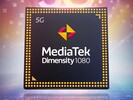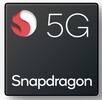MediaTek Dimensity 1080 vs Qualcomm Snapdragon 695 5G vs MediaTek Dimensity 1300
MediaTek Dimensity 1080
► remove from comparison
The Mediatek Dimensity 1080 is a mid-range ARM SoC (system-on-a-chip) that can be used in both smartphones and tablets (mainly Android). The SoC integrates two ARM Cortex-A78 cores with up to 2.6 GHz for demanding tasks and six power-saving ARM Cortex-A55 cores with clock rates of up to 2 GHz.
The chip has an integrated sub-6 GHz 5G modem including dual-SIM support that can reach a maximum download speed of up to 2.77 Gbit/s. Wi-Fi 6 (802.11ax) is supported as well as Bluetooth 5.2.;
The memory controller copes with LPDDR4x or LPDDR5 working memory as well as UFS 3.1 mass storage. As an integrated graphics card, the SoC uses the ARM Mali-G68 MC4, which supports displays with 120 Hz as well as HDR10+ at a maximum resolution of 2,520 x 1,440 pixels.
The differences to the Dimensity 920 are minor, only the slightly higher maximum clock and a support for higher-resolution cameras can be found.
The MediaTek Dimensity 1080 is still manufactured in 6 nm.
Qualcomm Snapdragon 695 5G
► remove from comparison
The Qualcomm Snapdragon 695 5G (SD695) is a fast mid-range ARM-based SoC largely found on Android tablets and smartphones. It features 8 Kryo 660 called cores (64-Bit capable) that are divided in two clusters. A fast cluster of two cores with up to 2.2 GHz based on the ARM Cortex-A78 design. And a power saving efficiency cluster with up to 1.7 GHz based on much smaller ARM Cortex-A55 cores. Both clusters can also used together. The successor of the SD695 is the Snapdragon 6s Gen 3 with slightly higher clocked cores.
In addition to the 8 CPU cores, the SoC integrates a lower mid range Adreno 619 GPU, a X51 5G radio (up to 2.5 Gbits download, no mmWave), a 802.11ac (Wi-Fi 5, 8x8 sounding, Dual Band, 2x2), a Bluetooth 5.2 radio, satellite positioning (GPS, QZSS, GLONASS, SBAS, Beidou and Galileo) and a video engine (support for H.265, H.264, VP8 and VP9).
Compared to the previous SD690, the SD695 is now manufactured in 6nm (instead of 8nm) and offers a higher clocked performance cluster. However, the SD695 only supports Wi-Fi 5 instead of Wi-Fi 6 of the SD690.
MediaTek Dimensity 1300
► remove from comparison
The Mediatek Dimensity 1300 is a high-end SoC with an integrated 5G modem. It includes three CPU clusters. One fast ARM Cortex-A78 at up to 3 GHz with 2x L2 cache, 3 additional A78 with up to 2.6 GHz and for power efficiency four ARM Cortex-A55 cores at up to 2 GHz. The SoC looks to be identical to the older Dimensity 1200.
Furthermore, the chip integrates a 9 core ARM Mali-G77 MC9 GPU, a Wi-fi 6 modem (ax), a LPDDR4x memory controller (up to 5266Mbps), a AI processing unit (APU 3.0 with 6 cores) and video de- and encoding (including AV1).
The chip is manufactured in the modern 6nm process and should be very power efficient.
| Model | MediaTek Dimensity 1080 | Qualcomm Snapdragon 695 5G | MediaTek Dimensity 1300 |
| Codename | Cortex-A78 / A55 | Kryo 660 Gold (2x Cortex-A78) / Silver (6x Cortex-A55) | Cortex-A78 / A55 |
| Clock | 2000 - 2600 MHz | 1700 - 2200 MHz | 2000 - 3000 MHz |
| Cores / Threads | 8 / 8 | 8 / 8 2 x 2.2 GHz ARM Cortex-A78 6 x 1.7 GHz ARM Cortex-A55 | 8 / 8 |
| Technology | 6 nm | 6 nm | 6 nm |
| Features | 2x ARM Cortex-A78 (2.6 GHz), 6x ARM Cortex-A55 (2 GHz), ARM Mali-G68 MC4, 5G NR Sub-6 GHz, LTE | Adreno 619 GPU, X51 5G Modem, Hexagon 692 DSP, Spectra 355L ISP, FastConnect 6200 (Wi-Fi 5) | 1x ARM Cortex-A78 (3 GHz), 3x A78 (2.6 GHz), 4x ARM Cortex-A55 (2 GHz), ARM Mali-G75 MC5, APU 3.0, 5G Modem, MiraVision (4K HDR Video, 80MP Photo), Wi-Fi 6, Bluetooth 5.2, UFS 3.1, 16GB-4266 LPDDR4x Support |
| iGPU | ARM Mali-G68 MP4 | Qualcomm Adreno 619 | ARM Mali-G77 MP9 |
| Architecture | ARM | ARM | ARM |
| Announced | |||
| Manufacturer | i.mediatek.com | www.qualcomm.com | www.mediatek.com |
| Series | Qualcomm Snapdragon |
Benchmarks
Average Benchmarks MediaTek Dimensity 1080 → 100% n=13
Average Benchmarks Qualcomm Snapdragon 695 5G → 84% n=13
Average Benchmarks MediaTek Dimensity 1300 → 101% n=13
* Smaller numbers mean a higher performance
1 This benchmark is not used for the average calculation











